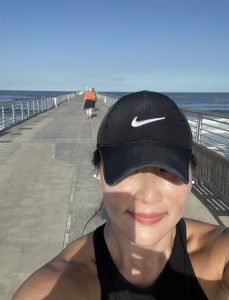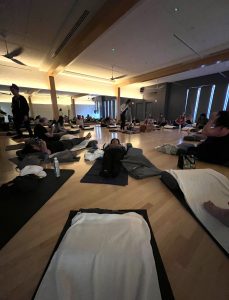We all formed bad habits during COVID, right? Many of us drank one too many glasses each day as the norm during the past two years. For me, I formed this habit during the pandemic which then carried into the last year as a buffer for my personal problems.
During separation/divorce, many people turn to bad habit(s) (at least in the short run,) to blunt their pain. I’ve heard people might become shopaholics, overeat, use drugs to numb, smoke, sleep around, and/or of course, drink too much alcohol.
Me? I became a binging Netflix-er on all series related to love and betrayal. I was also obsessed with audio books regarding relationships and self development. I was desperate for answers, and my mind would spin in search of them. I started running in the mornings more often to quiet my thoughts which was a positive, but each prior night I’d consume a minimum of 2 glasses of Sauvignon Blanc.

If we’re able to function during the day and get things done, and if people can’t tell we’ve been drinking, it means we can manage our alcohol, right? That’s what I thought, anyway. But then I noticed I could drink wine all day long if I wanted, which made everything feel more muted. In pain, but blunted, this felt better than sitting in my emotions. But it also left me not remembering details in my experiences I didn’t want to forget. My skin started looking weathered, my pores grew (dehydration.) Drinking made me moody and sometimes belligerent. I woke up multiple times a night. And worst of all, I started feeling like I “had” to have a drink at the end of each day.
3 weeks ago, I decided I had enough. I didn’t like the alcohol habit I had formed and wanted a way out. To figure out a plan, I researched the science of habits and how we form our routines. In doing so, which you will read below, I was able to shift my weekday habit of alcohol to working out with weight classes and yoga instead. Using a replacement worked best for me as 1) It was a distraction and 2) I was able to use the endorphins from exercise to associate the positive feelings from working out to retrain my brain toward wanting that over a drink.

I’ve been doing great so far with my work out replacement! My goal is now to socially drink on weekends only. I followed the steps below to implement breaking my alcohol habit. It helped to think about and prepare for the cues that would make me crave a drink so I could combat the feeling before it happened. If you’re looking to break a habit, see below for more!

Body Pump Class using free weights!

Sound Bath Meditation
Many habits—including drinking, smoking or excess sugar consumption – involve the brain’s dopamine (or reward) system. Dopamine is a “feel-good” chemical that transmits signals between neurons in the brain. The first time you engage in a new, rewarding behavior, you get a euphoric feeling from doing it. This leads to changes in both the connections between neurons and the brain systems responsible for actions.
Habits are shortcuts of the mind. They’re things we can do quickly without thinking because we’ve done them so often they’ve become automatic.
The Psychology of Bad Habits
One important feature of habits is that they’re triggered by cues in our environment. The trigger could be a time of day, a particular place, or how you’re feeling.
There are three distinct stages of habits:
1. Cue
2. Routine
3. Reward
For instance, the end of the day drink is cued by being finished with work, or by the time. 5pm can trigger a routine: get up and head to the kitchen. The reward? A glass of wine that gives you a temporary feeling of relaxation = Dopamine.
The habit loop is powerful and is something that gets hardwired into our psyches.
Breaking a habit
Instead of trying to eliminate a bad habit cold turkey, replace one behavior with another. For example, at the end of the day when I’d normally reach for a glass of wine, I now leave for the gym. Having a healthy alternative helped me replace my habitual drink. It’s much easier to say, ‘When I have an urge for wine, I’ll go to the gym instead’ than ‘When I have an urge for a drink, I’ll just not drink.’”
One thing to note, timing is important for making a good behavior stick. The rewards for habit formation need to be immediate. That’s because dopamine operates on a time frame of seconds. Given dopamine’s short timeline, it doesn’t tap into the brain’s habit-learning mechanisms. This means we need to strategize by using dopamine to help reinforce a new habit. For example, I feel the effects of the endorphins (dopamine) when I do a workout class (habit.)
Putting the Habit Loop to Work
If you’re ready to change a bad habit, here are three steps for using the habit loop to change your behavior.
Step 1: Identify the stages
First identify the cue, routine, and reward that led to your habit. Look at the circumstances surrounding the behavior including the time of day, who you’re with, and what you’re feeling.
Step 2: Explore alternatives
Start small, be prepared
What alternative behaviors might provide a comparable reward to the one you are trying to eliminate? What else would give you a sense of accomplishment, happiness, relaxation — whatever core need your current “bad habit” is satisfying?
Create a list of options.
A new habit needs to begin with smaller steps. Preparation is key. With working out, for example, the first step might be to find a time — waking up 20 minutes earlier or planning to do it before dinner. The next step might be to set up cues that keep leading you in the right direction, such as putting on your workout clothes so you’re all ready to go and less likely to flake on your plan.
People need to get ready for the behavior. Breaking the behavior down into smaller steps and tying it into a chain of events can help reinforce it.
Step 3: Commit to change and tweak as you go
Commit to try new routines and approach them as test runs. Things may not work the first time around. Adjust, and try again.
Step 4: Anticipate setbacks
Behavior change is hard. No one is immune from the occasional slip-up, so when this happens, don’t beat yourself up or retreat into negative self talk.
Instead, make your habit loop bulletproof: anticipate and plan for setbacks. If you’re trying to stick to not drinking during the week, think through situations that might challenge this goal, like going to dinner out, socializing, or having a stressful day.
Once I learned how to work within the psychology of habits, rather than against it, I found much better success in overcoming my bad habits. Don’t get me wrong, I still get cravings, and sometimes anxiety in thinking I may break my cycle. When I feel “weak,” I’ll listen to an app I discovered – Reframe which is a behavioral change program re: alcohol. I’ll read medical facts about the negative impact of alcohol, or something similar, to retrain my mind about what alcohol actually is – a sedative which is not good for our bodies! I’ll also have a spindrift flavored water soda in a wine glass 😉
Whatever habit you want to break, try these steps above and see how they work for you! It’s all about retraining our minds. Easier said than done, but it makes sense, right? Good luck!





